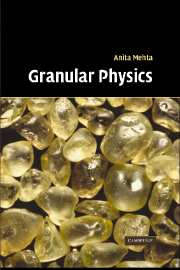Book contents
- Frontmatter
- Contents
- Preface
- 1 Introduction
- 2 Computer simulation approaches – an overview
- 3 Structure of vibrated powders – numerical results
- 4 Collective structures in sand – the phenomenon of bridging
- 5 On angles of repose: bistability and collapse
- 6 Compaction of disordered grains in the jamming limit: sand on random graphs
- 7 Shaking a box of sand I – a simple lattice model
- 8 Shaking a box of sand II – at the jamming limit, when shape matters!
- 9 Avalanches with reorganising grains
- 10 From earthquakes to sandpiles – stick–slip motion
- 11 Coupled continuum equations: the dynamics of sandpile surfaces
- 12 Theory of rapid granular flows
- 13 The thermodynamics of granular materials
- 14 Static properties of granular materials
- References
- Index
- Plate section
13 - The thermodynamics of granular materials
Published online by Cambridge University Press: 06 October 2009
- Frontmatter
- Contents
- Preface
- 1 Introduction
- 2 Computer simulation approaches – an overview
- 3 Structure of vibrated powders – numerical results
- 4 Collective structures in sand – the phenomenon of bridging
- 5 On angles of repose: bistability and collapse
- 6 Compaction of disordered grains in the jamming limit: sand on random graphs
- 7 Shaking a box of sand I – a simple lattice model
- 8 Shaking a box of sand II – at the jamming limit, when shape matters!
- 9 Avalanches with reorganising grains
- 10 From earthquakes to sandpiles – stick–slip motion
- 11 Coupled continuum equations: the dynamics of sandpile surfaces
- 12 Theory of rapid granular flows
- 13 The thermodynamics of granular materials
- 14 Static properties of granular materials
- References
- Index
- Plate section
Summary
Introduction
Many granular and particulate systems have been studied in the literature and there is a wide range of parameters and physical states that they support. Here we confine ourselves to jammed ensembles of perfectly hard particles. There are extensive studies in the literature of suspensions of particles in liquids or gases using various methods, including Stokes or Einstein fluid mechanics and Boltzmann or Enskog gas mechanics. These, however, are not jammed and we therefore discuss them no further. This chapter is not intended as a comprehensive review but rather as an interim report on the work that has been done by us to date.
The simplest material for a general jammed system is that of hard and rough particles, ideally perfectly hard and infinitely rough. To a lesser extent it is also useful to study perfectly hard but smooth particles. The former is easily available in nature, for example sand, salt, etc., and we prefer to focus on this case. Nevertheless, the discussion can be readily extended to systems of particles of finite rigidity, as has been shown recently. In jammed systems particles touch their neighbours at points, which have to be either predicted or observed. At these contact points the particles exert on one another forces that must obey Newton's laws. In general, determination of the structure and the forces requires prior knowledge about the history of formation of the jammed system.
- Type
- Chapter
- Information
- Granular Physics , pp. 209 - 232Publisher: Cambridge University PressPrint publication year: 2007
- 3
- Cited by



